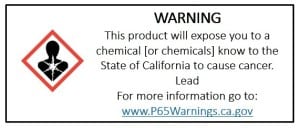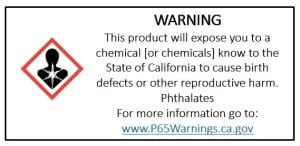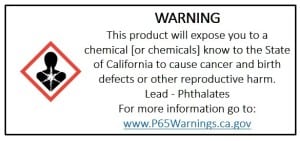Proposed Reforms to Proposition 65 Warnings
Proposed reforms to Proposition 65 warnings are on the agenda for discussion in an upcoming public workshop scheduled by California EPA’s Office of Environmental Health Hazard Assessment (OEHHA) on April 14, 2014. The purpose of the proposed reform is to “reduce unnecessary litigation and require more useful information to the public on what they are being exposed to and how they can protect themselves.” The proposal would “improve the quality of Proposition 65 warnings while providing both flexibility and certainty for businesses”. The proposal would establish three (3) to five (5) minimum elements required for warnings;
- Use of the signal word “WARNING”
- Use of the word “expose” to be consistent with language in the statute
- The standard (Globally Harmonized System) pictogram
 for toxic hazards (only for consumer products other than foods, occupational and environmental warnings)
for toxic hazards (only for consumer products other than foods, occupational and environmental warnings) - Disclosure of the names of up to 12 commonly-known chemicals that require warnings; Acrylamide, Arsenic, Benzene, Cadmium, Chlorinated Tris, 1,4-Dioxane, Formaldehyde, Lead, Mercury, Phthalates, Tobacco Smoke and Toluene.
- A link to a new OEHHA website to allow the public to access more information relating to the warning, including additional chemicals, routes of exposure, and if applicable, any actions that individuals could take to reduce or avoid the exposure.
The proposal outlines additional points which it says would “provide the public with better information and businesses with more regulatory certainty, clarity and additional warning options”;
- Provides an opportunity for small retailers (25 or fewer employees) to cure certain minor warning violations within 14 days and avoid any private enforcement whatsoever.
- Incorporates alternatives such as email (for environmental exposures) as well as automated processes that may be developed in the future, while maintaining existing options such as on-product warnings and signs.
- Includes tailored language for specific warning contexts (e.g. alcohol, drugs, medical devices, parking garages, hotels, apartments, and theme parks)
- Businesses may propose tailored warning methods and content for specific chemicals or exposure scenarios for adoption into regulations
- Recognizes warnings covered by existing court-approved settlements
The next steps outlined by the OEHHA are;
- Hold pre-regulatory public workshop on April 14, 2014
- Propose formal regulation in early summer of 2014
- Adopt final regulation in early summer 2015
- Develop website concurrent with regulatory process
An example of the proposed warning labels is shown below For consumer products OTHER than foods, prescription drugs, prescription medical devices or dental services shall at a minimum include the following;
For exposures to listed carcinogens |
 |
For exposure to reproductive toxins |
 |
For exposure to listed carcinogens AND reproductive toxins |
 |
Need help in better understanding Prop 65? Jacoby Solutions consultants can brief you on this issue and answer any questions related to your products. Contact us today and someone will get back to you promptly. email us at info@jacobysolutions.com or call 866-873-7335.

 for toxic hazards (only for consumer products other than foods, occupational and environmental warnings)
for toxic hazards (only for consumer products other than foods, occupational and environmental warnings)